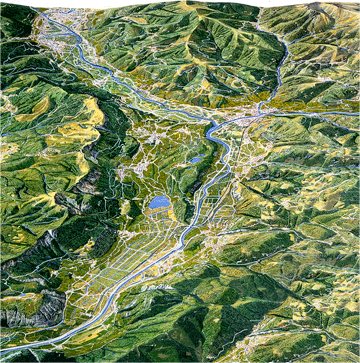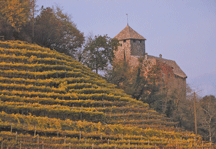
Alto-Adige map
©2010
Like many border areas in Europe, this precious parcel of wine-making heaven has been tossed between nations — here, Austria and Italy — and the wines reflect this double heritage. The Dolomites protect the vineyards from wind and allow the 300+ days of sunshine to work their magic above ground while the well-drained, limestone-laced soils nourish from below. I have a special fondness for these wines, which are at once voluptuous yet sophisticated, light yet focused. The complementary elements in the region’s geography are reflected in the wines, which yield an optimum mix of climate and viniculture.
The recent tasting at the Four Seasons Hotel in SF was one of the best it has been this reviewer’s pleasure to attend: the space was adequate for the number of people, lighting and food were perfect in forming an unobtrusive backdrop to the wines; noise levels were acceptable as were the lines in front of the stations. And no waiting at check-in. In short, for this five-star tasting kudos go to Cornerstone Communications for their excellent management of the event.
While the Alto Adige represents less than one percent of Italy’s total wine production, over 90% of its wines receive DOC designation. I don’t need to spell out what this means for a tasting trial: nearly every wine has that finish of careful cultivation and production that maximizes the glories of terroir and varietal and lend appeal even to wines you would not normally savor.
And in my case that would be Chardonnay, but Peter Zemmer’s Cortinie Bianco 2008 ($23) made a believer of me. With 50% Chardonnay, 30% Pinot Grigio, 10% Sauvignon blanc, and 10% Gewürz, this mélange balances richness with clarity: just the right hints of vanilla and apricot to brighten the strength of the fruit. The grapes undergo an eight-hour cold maceration before being pressed, then 2/3 of the fermentation occurs in steel tanks, the other third in small casks of French oak. Taste bud cinching acid with full fruit bouquet: true harmony prevails in this Alpine charmer.
Another favorite was Cortaccia Winery’s Lagrein Freinfeld 2005 ($33), a fine example of this native variety, which here displays its woodland fruit over a base of balsamic tannins: think berries with muscle. Lagrein is Alto Adige’s oldest autochthonous grape variety and formerly displayed a rough, often bitter finish, but decades of careful vinification — shorter maceration in old oak coupled with long barrel fermentation — have tamed the variety. This is a fine example of the “new” Lagrein. The 2005 is lovely now and will age well.

Alto-Adige Muller-Thurgau
Cortaccia also had my pick-of-show for best price/value ratio with their $16.00 Pinot Grigio 2008, presenting a refined profile of a perennial favorite. This one has the characteristic lightness of Italian Pinots Grigios with an intriguing edge of pepper and lemon to set off the aromatic linden and acacia blossoms. Crisp as a clean white shirt, supple as the dancer’s body beneath it.
Three stars and loud hosannas to Tramin Winery’s Gewürztraminer Nussbaumer DOC 2008 whose $40 price tag is modest for a beautiful expression of this variety with an expansive floral nose and a sensitive admixture of spice. Like all good Gewürz, this one sets off a tempest in the glass which transfers to the palate: that lovely whoosh of honeysuckle, vanilla, violets, litchi, melon, nutmeg, a hint of lemongrass and…and…and… Only after I tasted did I see that this winery is particularly known for its Gewürztraminers. I suppose the name should have told me!
Three stars also to Terlano’s Sauvignon Blanc Quarz 2007, worth every penny of its $55 price tag. The minerality is ethereal, the nose is wildflower bouquet over mixed citrus fruit, the acid balanced on a knife edge. 60% of the grapes are fermented in steel, 40% in wood, with no malolactic at all, which explains the soft brightness of this phenomenal Sauvignon. Your palate wants to explore it again and again to experience the unfolding complexities.
Also expressive of the purest Sauvignon fruit/acid balance is the Cantina San Michele Appiano Sauvignon St. Valentin DOC ($45) with an aromatic intensity to the vivacious fruit layering. Gooseberry, pineapple, ripe citrus flow in and out of one another on the palate…an uplifting and altogether sensuous Sauvignon.

Schloss Warth in Alto-Adige
But my pick of the tasting goes to H. Lun Winery’s Bianco Sandbichler Cuvee 2006 which, let me say straight off, would be a treat at trice the price, but isextraordinary at $24. An enticing blend of 50% Pinot Bianco, 33% Chard, 10% Riesling, and 7% Sauvignon, this white has a luminous quality which lets the characteristic citrus asperity bloom into flowers on the palate. Extraordinarily balanced, the grapes are fermented separately (in old oak) and assembled at the end of the aging. They are then blended and left for several weeks — just long enough to marry — in stainless steel tanks before bottling.
I did not have the opportunity to taste the native red, Schiava (locally known as Vernatsch) which has also achieved (so I am told) silkier tannins in the past several decades. Also for next time, I look forward to sampling this region’s vino santo (made from Nosiola grapes) and therefore different from the one produced in Tuscany (from Malvasia and/or Trebbiano grapes).
To next time!
& & &
